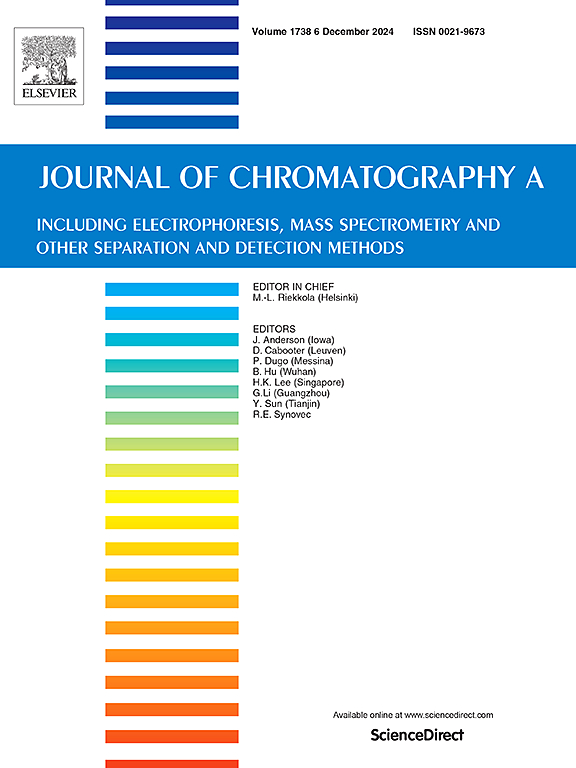1D-CNN支持的艾叶压缩色谱指纹图谱:利用化学计量算法减少流动相消耗
IF 4
2区 化学
Q1 BIOCHEMICAL RESEARCH METHODS
引用次数: 0
摘要
高效液相色谱法(HPLC)因其高灵敏度、稳定性和准确性而被广泛应用。然而,它通常涉及较长的分析时间和相当大的溶剂消耗,特别是在处理复杂的系统和质量控制时,对绿色和环保的分析实践提出了挑战。目的提出一种将一维卷积神经网络(1D-CNN)与高效液相色谱(HPLC)相结合的压缩指纹图谱分析技术,旨在提高复杂体系中各种化合物的分析效率,同时减少有机溶剂的使用。材料与方法以天然产物艾叶蒿(artemisisiae argyi Folium, AAF)为实验对象。首先,在常规程序的基础上建立了AAF的HPLC指纹图谱。然后,在不丢失复合信息的情况下获得压缩指纹。最后,利用1D-CNN深度学习模型对压缩色谱图进行分析和识别,实现了对复杂体系中10种化合物的定量分析。结果1D-CNN模型可以有效地从复杂数据中提取特征,每个样本的分析时间缩短约40 min,流动相的消耗比之前显著降低了78%。在待分析的10种化合物中,有9种获得了较好的结果,最高相关系数达到0.95以上,说明该模型具有较强的解释力。结论所建立的压缩指纹图谱识别技术提高了传统HPLC方法的环境可持续性和效率,为未来分析方法和设备的发展提供了有价值的见解。本文章由计算机程序翻译,如有差异,请以英文原文为准。
Compressed chromatographic fingerprint of Artemisiae argyi Folium empowered by 1D-CNN: Reduce mobile phase consumption using chemometric algorithm
Introduction
High-Performance Liquid Chromatography (HPLC) is widely used for its high sensitivity, stability, and accuracy. Nonetheless, it often involves lengthy analysis times and considerable solvent consumption, especially when dealing with complex systems and quality control, posing challenges to green and eco-friendly analytical practices.
Objective
This study proposes a compressed fingerprint chromatogram analysis technique that combines a one-dimensional convolutional neural network (1D-CNN) with HPLC, aiming to improve the analytical efficiency of various compounds in complex systems while reducing the use of organic solvents.
Materials and Methods
The natural product Artemisiae argyi Folium (AAF) was selected as the experimental subject. Firstly, HPLC fingerprints of AAF were developed based on conventional programs. Next, a compressed fingerprint was obtained without losing compound information. Finally, a 1D-CNN deep learning model was used to analyze and identify the compressed chromatograms, enabling quantitative analysis of 10 compounds in complex systems.
Results
The results indicate that the 1D-CNN model can effectively extract features from complex data, reducing the analysis time for each sample by about 40 min. In addition, the consumption of mobile phase has significantly decreased by 78 % compared to before. Among the ten compounds to be analyzed, nine of them achieved good results, with the highest correlation coefficient reaching above 0.95, indicating that the model has strong explanatory power.
Conclusion
The proposed compressed fingerprint chromatograms recognition technique enhances the environmental sustainability and efficiency of traditional HPLC methods, offering valuable insights for future advancements in analytical methodologies and equipment development.
求助全文
通过发布文献求助,成功后即可免费获取论文全文。
去求助
来源期刊

Journal of Chromatography A
化学-分析化学
CiteScore
7.90
自引率
14.60%
发文量
742
审稿时长
45 days
期刊介绍:
The Journal of Chromatography A provides a forum for the publication of original research and critical reviews on all aspects of fundamental and applied separation science. The scope of the journal includes chromatography and related techniques, electromigration techniques (e.g. electrophoresis, electrochromatography), hyphenated and other multi-dimensional techniques, sample preparation, and detection methods such as mass spectrometry. Contributions consist mainly of research papers dealing with the theory of separation methods, instrumental developments and analytical and preparative applications of general interest.
 求助内容:
求助内容: 应助结果提醒方式:
应助结果提醒方式:


